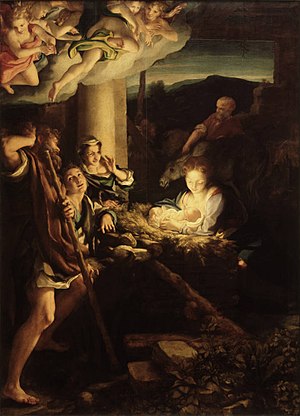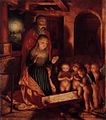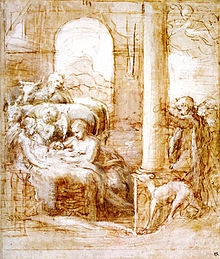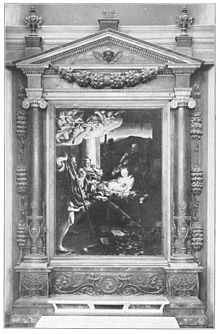The Holy Night (Correggio)

|
| The holy night |
|---|
| Antonio da Correggio , between 1522 and 1530 |
| Poplar wood |
| 256.5 x 188 cm |
| Old Masters Picture Gallery |
The painting The Holy Night by Correggio is in the Gemäldegalerie Alte Meister in Dresden .
Image description
" The Heil. Night. The stable forms a ruin with columns. On the right, Mary kneels and looks delighted at the baby Jesus, whom she is holding with both arms over the straw of the manger. A bright light emanates from the child and illuminates, like the face of his mother, also the adoring shepherds to the left of the manger. At the very front stands a bearded elderly shepherd, who moves lively and leans on a mighty staff; in the middle kneels a younger one who has put his left arm on the manger and looks blissfully at heaven; A little further back, finally, at the pillar, stands a maid who, blinded, holds her left hand in front of her face. A dog stands at the feet of the shepherds. Joseph is busy with the donkey in the middle distance to the right. At the top left, however, a group of adolescent angels with strangely tangled limbs appears, descending in clouds. In the background a dusky blue landscape. "
The picture picks up on an incident from the Protevangelium of James : On the way to Bethlehem, Mary went into labor pains. Joseph only found a cave as accommodation, into which he led Maria, then he looked for a midwife. When he returned, a cloud covered the cave, which retreated and a great light filled the cave so that the eyes could not bear it. . .
This image idea of the sacred luminous light referred to in literature was taken up by various painters before Correggio, first by painters in Flanders such as Geertgen tot Sint Jans and Hugo van der Goes .
Story of the picture
Emergence
The history of the painting can be completely traced back to the day on which the idea for this painting was written down in a document. On October 14, 1522, a contract between Alberto Pratoneri and Correggio was signed in Reggio with the following content:
“Reggio, October 14th, 1522.
With this writing from my hand I announce Alberto Pratonero to everyone and to know that I am committed to give two hundred and eight lire old coin from Reggio to the master Antonio da Correggio, painter, and as payment for a board, which the same promises me to make in all excellence and on which the birth of our Lord is to be painted, with all the figures belonging to it, according to the dimensions and the size indicated on the handwritten drawing the same master brought Antonio to me.
On the day noted above, I paid him forty lire of old coin as part of the price.
"And I, Antonio Lieto von Correggio, confess that on the days and years noted above I received as much as is written above, and as a token of this I have written this with my hand."
It is not known which drawing the master presented to his client and it is also unlikely that a finished composition of a picture was presented as early as 1522, but it is certainly appropriate to refer to a drawing by Correggio from this period.
The painting was probably completed in 1530 and placed in a magnificent setting at its destination, the Pratoneri Chapel in the Church of San Prospero in Reggio nell'Emilia.

effect
In the 16th century the work was not yet famous; only with its rediscovery by Annibale Carracci in his lost picture Adoration of the Shepherds , of which there is a fairly exact copy by Domenichino , this was changed:
This picture therefore gave the impetus for a further dissemination of the motif, since it gave a satisfactory answer to a particular topic of art.
owner
The quality of the picture aroused desires from different sides. Already before 1590 Alfonso II. D'Este was interested in the painting in order to incorporate it into his collection, but did not get a chance due to the consequent refusal of a sale by the Pratoneri heirs and the clergy of San Prospero. The art-loving Philip IV of Spain also wanted Correggio's painting for his collection and wanted it as a gift from Duke Francesco I d'Este , who in turn had plans of his own for his gallery in Modena and left the painting out of the church without further ado steal. In an entry in the church book of S. Prospero from May 1, 1640 it was noted that this was done "to the greatest pain of the entire population". As a replacement, the parish only received a copy of the Modenese court painter Jan Boulanger in 1686 by order of Cardinal Rinaldo d'Este , the son of Francesco , which is still in this place today.
The paintings "The Madonna of St. Matthew" by Annibale Carracci and "Madonna Enthroned with Three Saints" by Guido Reni , which were in the Galleria Estense in Modena, along with other paintings by Correggio , also come from the Church of San Prospero .
After the lost Austrian War of Succession , Duke Francesco III went. d'Este went into exile in Venice and was forced to sell valuable works of art for lack of money. The Saxon Elector and King of Poland August III. Since an educational trip to Italy from 1711–1719, he was very interested in Correggio's pictures, which were also the reason to enter into the deal that had been threaded through the art agent Bonaventura Rossi to take over 100 pictures from the Modenesische Galerie for 100,000 Zechinen . The purchase contract also included the replacement of the picture with an excellent copy made by Giuseppe Nogari , which is still in the Galleria Estense today.
"The Holy Night" by Correggio has been in Dresden since September 1746, a picture that was entered in the inventory of paintings as the "famosa notte", famous throughout Europe. Before 1800 it was the most famous picture in the Dresden collection and was replaced by the Sistine Madonna .
Web links
Individual evidence
- ↑ a b c d e Birgit Kloppenburg, Gregor JM Weber: La famosissima Notte! , Edition Imorde, Emstetten / Dresden 2000, pp. 8–35.
- ↑ a b Harald Marx (Ed.) Gemäldegalerie Alte Meister Dresden, Volume 1: The exhibited works , Verlag der Buchhandlung Walther König, Cologne 2005, pp. 88–89.
- ^ Julius Meyer: Correggio. Published by Wilhelm Engelmann, Leipzig 1871, p. 307.
- ^ Hans Posse: Die Gemäldegalerie zu Dresden , Verlag Julius Bard, Berlin and Verlag der Wilhelm und Bertha v. Baensch Foundation, Dresden 1920, p. 13.












